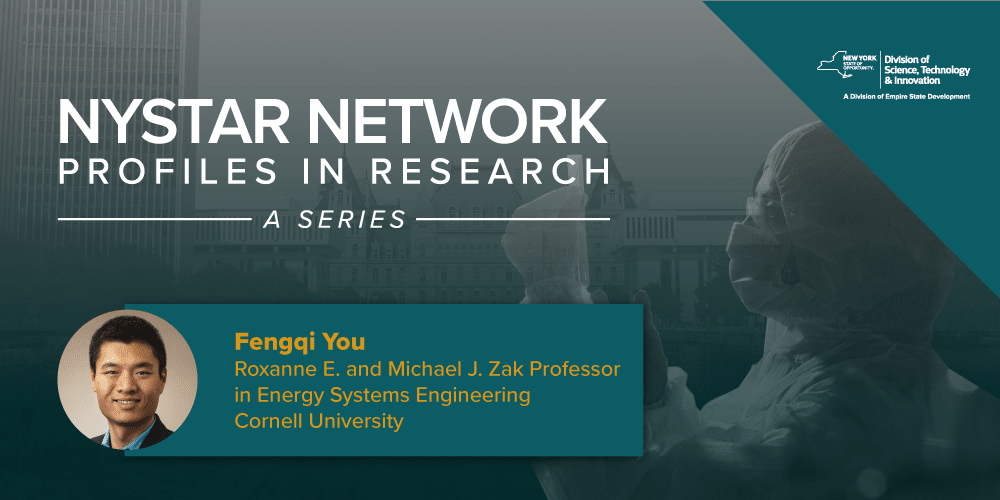Cornell engineering professor works with NYSTAR-funded center to create a complete picture — and settle the debate — on the environmental impact of using biodegradable raw materials in medical gowns
What are the best ways to recycle disposable medical gowns, masks, and other one-time-use personal protection equipment?
It was an interesting question, raised at the height of the COVID-19 pandemic. The possibilities piqued the interest of Dr. Fengqi You, an engineering professor in Cornell University.
But the New York Embroidery Studio (NYES) asked something different, which led Dr. You down an unanticipated path.
Instead of looking at how to recycle these products, how about starting the process by making hospital gowns out of biodegradable material? Would that be better for the environment?
The company approached the Cornell Center for Materials Research (CCMR), funded by New York State’s Division of Science, Technology and Innovation (NYSTAR) for help finding an answer.
That’s when Dr. You, the Roxanne E. and Michael J. Zak Professor in Energy Systems Engineering, came on board to look at the overall “energy system” of biodegradable medical gowns. He analyzed more than just the makeup of materials that could be used in the manufacturing process; his research took the total lifecycle of biodegradable medical gowns into account — from production to disposal.
“It’s not only looking at a single stage of how we make it, but also how we use it, and at the end of the product’s life, how we dispose of it, which is critical,” Dr. You said. “During the pandemic, people were looking for a better process to recycle and dispose these medical gowns and face masks, but NYES had an interesting question about deciding what kind of materials to use in the gown.”
Suppliers touted using biodegradable raw materials, which, at first glance, seemed promising. But the available research at that point was too limited to draw any conclusions.
“In this case, CCMR was more than just a third-party doing auditing. We worked to understand from a scientific level if this was the right thing to do or not, in a rigorous and systematic way” Dr. You said.
He found that while there were some differences between using biodegradable versus conventional raw materials in the manufacturing process of medical gowns, the impacts on the environment would be negligible. Likewise, there was no difference in the wearing of the gown.
However, he made a significant discovery in the disposal process.
“Biodegradable gowns will degrade faster than traditional ones, and we systematically evaluate on whether that’s really good or bad,” Dr. You said. “It sounds like, ‘Oh degradable. It’s always good!’” We took a systems approach, looking at the whole system very comprehensively, and found out in this particular case, that degrading faster is actually worse because the used product releasing emissions into the air faster in the degradation process.”
Ultimately, Dr. You’s research showed that biodegradable medical gowns would not have a net environmental benefit, unless the landfill gas capture efficiency could reach 85%. While it wasn’t the result NYES had hoped for, the research allowed the organization to make an informed business decision.
“While disappointing, this analysis was really a huge success, as we were able to avoid further investment into [this] technology,” said Mike Saxon, general manager at NYES. “We’ve gone on to use this data to develop alternate strategies, such as promoting reusable gowns. We’ve also shared this research with other firms who were exploring the technology and help them focus their efforts elsewhere.”
Dr. You is eager for similar projects which bring marketplace-based problems to researchers, particularly as he explores the next frontier in advanced materials research: artificial intelligence.
Serving as the co-director of the Cornell University AI for Science Institute (CUAISci), he sees great potential for using AI as a tool in advanced materials research as academics and companies continue to search for more sustainable raw materials and processes.
“This particular domain of material research has traditionally relied on trial and error, and that takes a long time to validate solutions,” Dr. You said. “AI can speed that up. I think for material research, there are so many opportunities that we could explore, because these are new tools like generative AI that could help us develop something more powerful.
“We are doing interesting research driven by societal needs.”
Visit CCMR and NYSTAR online to find our more information about the programs and ways in which business and research are transforming New York’s innovation economy.

